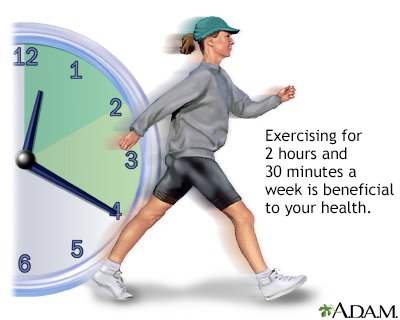Managing your chronic back pain
Managing chronic back pain means finding ways to make your back pain tolerable so you can live your life. You may not be able to get rid of your pain completely, but you can change some things that worsen your pain. These things are called stressors. Some of them may be physical, like the chair you sit in at work. Some may be emotional, like a difficult relationship.
Chronic back pain
Low back pain refers to pain that you feel in your lower back. You may also have back stiffness, decreased movement of the lower back, and difficult...

Reducing stress can improve your physical and emotional health. It is not always easy to reduce stress, but it's easier if you are able to ask your friends and family for help.
Make a List
First, make a list of what makes your back pain better and what makes it worse.
Then try to make changes in your home and work to decrease the causes of your pain. For example, if bending to pick up heavy pots sends shooting pain down your back, rearrange your kitchen so that the pots are hanging from above or are stored at waist height.
If your back pain is worse at work, talk to your boss. It may be that your workstation isn't set up correctly.
- If you sit at a computer, make sure that your chair has a straight back with an adjustable seat and back, armrests, and a swivel seat.
- Ask about having an occupational therapist or other expert assess your workspace or movements to see if changes such as a new chair or cushioned mat under your feet would help.
- Try not to stand for long periods. If you must stand at work, rest one foot on a stool, then the other foot. Keep switching the load of your body's weight between your feet during the day.
Long car rides and getting in and out of the car can be hard on your back. Here are some tips:
- Adjust your car seat to make it easier to enter, sit in, and get out of your car.
- Bring your seat as far forward as possible to avoid leaning forward when you are driving.
- If you drive long distances, stop and walk for a few minutes about every hour.
- Do not lift heavy objects right after a long car ride.
These changes around your home could help relieve your back pain:
- Raise your foot up to the edge of a chair or stool to put your socks and shoes on instead of bending over. Also consider wearing shorter socks. They are quicker and easier to put on.
- Use a raised toilet seat or install a handrail next to the toilet to help take pressure off your back when you sit on and get up from the toilet. Also make sure the toilet paper is easy to reach.
- Don't wear high-heeled shoes. If you must wear them sometimes, consider wearing comfortable shoes with flat soles to and from the event or until you must put on high heels.
- Wear shoes with cushioned soles.
- Rest your feet on a low stool while you're sitting so that your knees are higher than your hips.
Rely on Friends and Family
It is important to have strong relationships with family and friends you can depend on when your back pain makes it hard to get through the day. If a relationship is causing stress, consider working with a counselor to find ways to resolve conflict and strengthen the relationship.
Establish Life Routines
Set up good life habits and routines such as:
- Exercise every day for about 30 minutes. Walking is a good way to keep your heart healthy and your muscles strong. If walking is too hard for you, work with a physical therapist to develop an exercise plan that you can do and maintain.
- Eat foods that are low in fats and sugar. Healthy foods make your body feel better, and they decrease your risk of being overweight, which can cause back pain.
Healthy foods make your body feel bette
The foods and drinks you choose are important for maintaining a healthy weight. This article offers advice on making good food choices to manage you...
 ImageRead Article Now Book Mark Article
ImageRead Article Now Book Mark Article - Reduce demands on your time. Learn how to say yes to things that are important and no to those that are not.
- Prevent pain from starting. Figure out what causes your back pain, and find other ways to get the job done.
- Take medicines as needed.
- Make time for activities that make you feel relaxed and calm.
- Give yourself extra time to get things done or to get where you need to go.
- Do things that make you laugh. Laughter can really help reduce stress.
Reviewed By
Jacob Berman, MD, MPH, Clinical Assistant Professor of Medicine, Division of General Internal Medicine, University of Washington School of Medicine, Seattle, WA. Also reviewed by David C. Dugdale, MD, Medical Director, Brenda Conaway, Editorial Director, and the A.D.A.M. Editorial team.
El Abd OH, Amadera JED. Low back strain or sprain. In: Frontera WR, Silver JK, Rizzo TD Jr, eds. Essentials of Physical Medicine and Rehabilitation: Musculoskeletal Disorders, Pain, and Rehabilitation. 4th ed. Philadelphia, PA: Elsevier; 2019:chap 48.
Lemmon R. Chronic low back pain. In: Rakel D, Minichiello VJ, ed. Integrative Medicine. 5th ed. Philadelphia, PA: Elsevier; 2023:chap 66.

 All rights reserved.
All rights reserved.